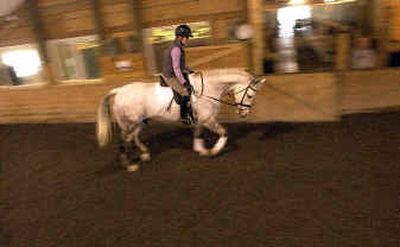Trainer working toward goal of dressage Grand Prix

POST FALLS – The horse’s hooves beat a rhythmic thud as it circles the trainer, who scrutinizes both the horse and its rider. Dust particles form a blanket of haze that grows thicker with each step of the horse’s purposeful gait. All the while, the trainer’s confident voice calls out a steady stream of commands. She is oblivious to the bustle in the stalls adjacent to the indoor arena. Mary Richmond Brown is wholly immersed in one of the two activities she loves most: training and dressage.
Brown’s confident voice and fearless stance inside the Post Falls Equestrian Center’s arena belie her petite stature, but she knows horses, having been raised in a family of horse riding competitors. Her grandfather, George Richmond, of Hayden, competed successfully in rodeos and was a calf-roping trainer. Brown’s younger sister is a rodeo barrel racer. In this area, people are familiar with calf-roping and barrel racing, but for most, dressage is foreign.
“When I first tell people what I do, they usually give me an odd look. Most people have never heard of dressage. Western-style riding definitely overshadows dressage in this area,” said Brown.
Dressage, an Olympic equestrian sport, is derived from the French word “dresser,” meaning to train, and is most popular on the East and West coasts. According to the United States Dressage Federation, “Dressage requires a horse and rider to combine the strength and agility of gymnastics with the elegance and beauty of ballet.” Such skills are showcased in a series of figures and movements, which a horse performs upon demand. A rider communicates what to do through subtle body movements, including such signals as a leg squeeze and the shifting of weight in the saddle.
Brown’s mother enrolled her in English riding lessons when she was 9 years old. She also took jumping and English and Western riding lessons in 4-H. When Mary was about 11 years old, her mother took her to the Deep Creek Horse Trials in Medical Lake, where she watched eventing competition for the first time. It was then she decided what she wanted to pursue jumping.
“Eventing competition incorporates dressage, stadium jumping and cross country jumping. All of this was very exciting to me,” Brown said. “I really loved jumping, and dressage just happened to be part of competition.”
Throughout high school, she won some local competitions and was even named Regional Reserve Champion. However, when she went to the University of Idaho, she suddenly found herself short on time and financial resources. Brown got creative. She leased horses, traded work for lessons and bought used equipment.
Janaira Johnson, who also trains at the Post Falls Equestrian Center and was recently named Reserve Champion at the Northwest Dressage Championships, attests to this. “People view this sport as elitist, but there are ways for the average person to make it affordable that people don’t always see. I braid (horsetails) and groom at shows for other dressage competitors. I clean stalls for reduced board. I also work horses for my trainer to get discounts off lessons.”
Brown’s focus shifted away from jumping and toward dressage during her college years because the horses available to her for the least amount of money were dressage-trained horses beyond prime competition age.
In November 2003, Brown began riding an 8-year-old thoroughbred/quarter horse cross with a Percheron sire. In June, she purchased the horse, named Montana. Her dream of someday competing in the Grand Prix, which is the pinnacle of dressage competition, is dependent, in part, on Montana’s immense potential. She credits the horse’s former owner, Linn Mitchell, for his sound training foundation.
This past season had hints of greater seasons to come. She competed in the professional divisions and came away with seven first-place finishes and two third-place finishes in 11 classes at four shows. At two shows she was named Reserve Champion. She placed fourth at the USDF Region 6 Championships.
Yet, potential still requires many hours of training and dedication. Brown trains 10 to 15 hours a week with her trainer, Pat Kabasa, throughout the year. During dressage show season, from March to October, she participates in about one show a month, depending on her show budget.
The clinics are an invaluable resource because of the two men who fly to the area specifically to teach at the clinics. Dietrich von Hophgarten and Steve Kannikkeberg are both well-known in the national dressage community. Von Hophgarten has trained multiple students who have competed on the United States Equestrian Team, including one student who competed in this summer’s Olympic Games. Kannikkeberg, a native Idahoan, is a USDF gold medalist, with many awards and distinctions.
Brown believes her continuous training ultimately makes her a better trainer. Training other riders also helps financially support her riding. Although she taught a few lessons in college, she didn’t feel she had the education or experience to teach dressage full time. Instead, she chose to focus on her own riding. More than a year ago, after a trainer left the equestrian center, Kabasa suggested Brown begin teaching lessons. She began teaching one lesson a week and had enough clients after six months to quit her day job to train full time.
She currently teaches 30 to 35 lessons a week and her students range in age from 5 to 60. Students are only required to have helmets and riding boots, but Brown does have extras in case a student cannot afford them. “Schooling” horses are stabled at the Post Falls Equestrian Center and are available to students who do not own horses.
While her personal goals include the Grand Prix and a USDF bronze medal, her professional goals are simpler: “I want people to be educated about dressage. There are many misconceptions about the sport. But what is most important to me is teaching good horsemanship. I want people to have good basics, skills that translate to all styles of riding – English or Western.”